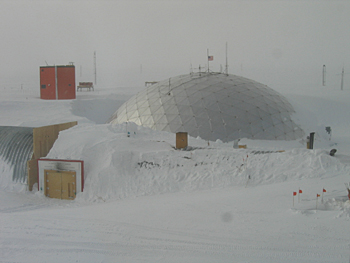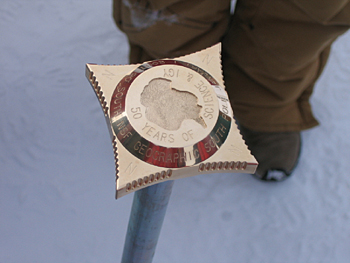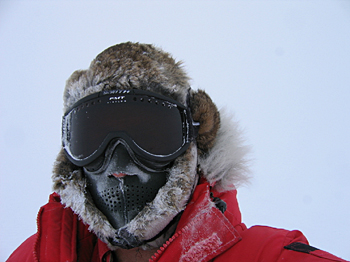Click here to view slideshow
Editor's note: This is one in a series of articles featuring UD polar scientists that will appear on UDaily during the International Polar Year. For a gateway to past and future articles, be sure to visit UD's polar research web page.
2:34 p.m., June 15, 2007--James Roth, a senior electronics and instrumentation technician in UD's Department of Physics and Astronomy, recently completed his fourth season in Antarctica, working on UD's “IceTop” project. His blog from the South Pole on Jan. 15 provides insight into what it's like to live and work on the harshest continent on the planet.
What's it like living at the South Pole? I'll try to sum it up. South Pole Station is located at the geographical South Pole. It is on top of a two-mile-deep glacier. It is the coldest, highest and driest desert on Earth.
There has been a lot of change at the pole over the last several years. The new, elevated station has been under construction to replace the Dome, which is slowly being buried by annual snowfall. The Dome had been the home for South Pole residents for over 30 years, but it is being dismantled as operations are shifted to the new station. The new, elevated station houses summer residents as well as the winter-over crew that will stay all year, through the six months of darkness.
There are now two places that house summer residents at the pole. Summer camp has several cloth-covered huts called "jamesways." Most are living quarters, but there is also a lounge where you can hang out and maybe watch a movie. The jamesways are heated, but the floors are still pretty cold. They are dark inside, so sleeping in the 24-hour sunlight is no problem. The bathrooms and showers are located in a separate building at the center of summer camp. That means that you have to come out from your warm, dark room into the bright, cold to go to the bathroom. I stayed in the jamesways two years ago.
The station and summer camp are just about bursting at the seams with the current population of 266 people. I think that is close to a record. The station was not designed to handle so many people. There are two major experiments under construction in addition to the station construction itself and many other smaller experiments.

The new station has all the comforts of home. It has the galley and kitchen, bathrooms and showers, a laundry room, TV lounges, a recreation room with a pool table and a ping-pong table, a gym and a greenhouse. There is even a recreation room where you can play an instrument. There is enough equipment for a complete band. There are, of course, administrative offices and conference rooms, too.
One of the best things about the pole is the food! In fact, your day revolves around the galley schedule. In 24 hours of daylight, the only way to know it's morning is because the galley is serving eggs! I'm told your body burns up to 40 percent more calories trying to keep warm while working outside at the pole.
They feed you very well here. There are three meals a day, plus midnight rations (“midrats”) for the night shift. Despite the good food, most people lose weight here. Well, most people except me! I've got to stay away from the cookies and ice cream!
Generators supply power, heat and water to the station. They run on JP-8 jet fuel brought in by the C-130 aircraft that supply the station. Without the generators, we couldn't survive at the pole. You know how expensive gas is at home. Imagine how expensive jet fuel is and add to it the cost of flying it to the South Pole! It takes 336 C-130 flights during the summer to support the station and the science through the winter. Power and water conservation is always in progress. We are only allowed two showers a week for two minutes. Shower days, I feel like a new person!
While the new station makes you feel at home, we are still on the harshest continent on Earth. When most people think of the South Pole, they think about the cold. How cold is it? The average summer temperature is 35 degrees Celsius below zero. Right now, at mid-summer, the typical day is -15 to -20 degrees C. The wind chill makes it feel a lot colder.Most summer days that I've been here, the winds have been mild. The last two days, however, we've had a storm with wind sustained at 24 knots. That drives the wind chill down into the -40s or colder. This morning, I walked about three-quarters of a mile to one of my work sites. It was nearly a complete white-out. If not for the flags along the route, I could have easily gotten lost.
We are well-prepared for the cold. Our ECWs (Extreme Cold Weather clothing) are issued in Christchurch, New Zealand, by Raytheon Polar Services' clothing distribution center. Even in the extreme cold, I can usually work outside for several hours at a time. Again, eating a good meal helps keep you warm. If you are working outside, especially in the wind, you have to keep all skin covered or you will get frostbite!
The cold is easy to handle by dressing properly. There are other issues to deal with at the pole that most people don't think of. We are at a pressure altitude of 10,000 to 11,000 feet. Up here, the air is very thin. It takes days to weeks to get used to breathing such little oxygen. This year alone, six people had to be evacuated in 10 days for Acute Mountain Sickness (AMS). Your body does finally adjust. After a month at the pole, I'm getting around pretty good, but climbing steps still sucks the wind out of me!
The other issue here is humidity, or the lack thereof! It is for the most part 0 percent humidity. It is very important to stay hydrated. You are issued a water bottle in Christchurch. It is with you always! It's even within reach when you sleep. Chapstick and moisturizing lotion are also essentials.

Text and photos by James Roth




